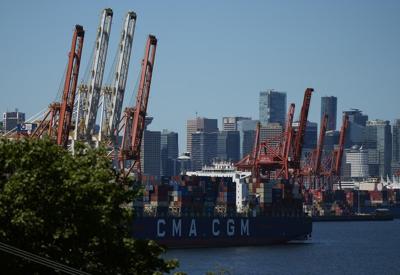OTTAWA - 好色tv exports of thermal coal increased another seven per cent last year, reaching the highest level in almost a decade.
The boom in exports of the kind of coal burned to make electricity comes as Canada leads a charge to end the use of coal as a source of power worldwide, including at home.
The Liberals also promised three years ago that all thermal coal exports will stop from Canada by 2030, but exports have risen almost 20 per cent since that promise was made.
Statistics published this month by the ports of Vancouver and Prince Rupert show 19.5 million tonnes of thermal coal were exported through their terminals last year.
That's up from a little more than 18 million tonnes in 2022 and is almost twice the amount Canada exported in 2015 when the Liberals took power.
In 2022 more than half Canada's exports were coal produced in the United States, mainly Wyoming and Montana, that is shipped by rail to Vancouver and then across the Pacific. Most U.S. west coast ports won't allow thermal coal exports anymore, said Fraser Thomson, a staff lawyer at Ecojustice.
Thomson said the 好色tv government has to step in and live up to its promise to stop both 好色tv-made exports and the coal coming through Canada from the U.S.
"There's really no time to waste," he said.
"They promised this in 2021 and we've seen the cost of inaction. Coal exports keep going up, this issue is getting worse and it's not going to resolve itself. It requires definitive action, and the federal government is the government that can do it."
Coal is considered the dirtiest fuel for making electricity when it comes to greenhouse gas emissions and air pollution. It produces almost twice the amount of carbon dioxide when burned as natural gas to make the same amount of energy.
Global coal use expanded in 2022, partly as the Russian invasion of Ukraine led to a spike in gas prices. The International Energy Agency said in its most recent forecast that it believes thermal coal demand may have peaked in 2023.
China accounts for more than half the world's use of thermal coal, and India almost 15 per cent.
Environment Minister Steven Guilbeault said last month he expects to announce a plan to phase out coal exports later this year.
NDP MP Laurel Collins got tired of waiting for Guilbeault to act and in February introduced a private member's bill to force the end of coal exports. The bill has not yet been debated.
She said Friday she is exasperated by the continued increase in coal exports.
"Even after I tabled my motion they simply repeated the same thing that they've been saying for years now, which is that they intend on phasing out thermal coal exports and yet the facts refute their claims. There has been no action."
Collins said there are workers whose jobs depend on coal, who need a transition plan and time to adjust to different industries. If the government doesn't move soon there won't be enough time for that adjustment and workers will be harmed.
She also said Canada has been lauded as a leader in ending coal power, and yet it is still exporting the problem.
Canada and the United Kingdom also launched the global Powering Past Coal Alliance seven years ago to encourage all countries to cut back on the use of coal as a source of power.
Canada's domestic use of coal power has fallen dramatically, helped by Ontario's decision to close all its coal power plants. The last one in that province closed in 2014.
Alberta's last two coal plants are transitioning to natural gas this year.
Saskatchewan, New Brunswick and Nova Scotia are the only other provinces with significant reliance on coal, but regulations require them to close them, transition them to gas, or equip them with emissions capture technology by 2030.
Despite all that, Thomson said Canada continues to ship coal overseas.
"What happened when the Liberals brought in the effective ban on burning coal domestically, the idea was that the coal mines that were supplying those plants would be shuttered and eventually that industry would transition," he said.
"What we've seen since that time is domestic production of coal has skyrocketed threefold, and the government seems to not be doing anything about it despite promises to tackle it."
Almost all of the thermal coal Canada produces comes from coal mines in Alberta and is exported, mainly to Asia, from ports in B.C.
This report by 好色tvwas first published March 29, 2024.








































